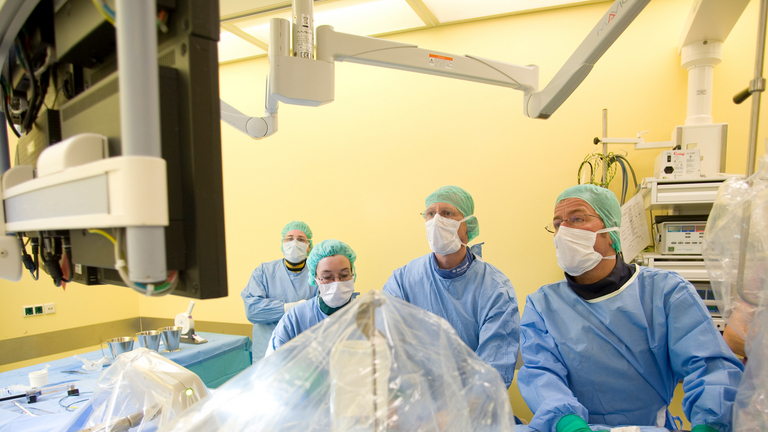
TAVI
TAVI stands for transcatheter aortic valve implantation, a minimally-invasive catheter-based procedure that is used for the implantation of prosthetic tissue valves. In contrast to aortic valve replacement, this procedure does not involve the removal of the diseased valve.
Contact
What is TAVI?
A minimally-invasive, catheter-based technique for the implantation of a prosthetic aortic valve in high-risk surgical patients. For patients who are at an increased risk of surgical complications due to their age or concomitant disease, transcatheter aortic valve implantation (TAVI) offers a catheter-based alternative to open-heart valve replacement surgery. During this procedure, a prosthetic tissue valve is mounted on a catheter and implanted using a catheter delivery system. Access is usually via the blood vessels in the groin (transfemoral) or via the apex (tip) of the heart (transapical).
In contrast to valve replacement using open surgery, this procedure does not involve the removal of the diseased valve. Instead, the prosthesis is inserted in such a way as to push the native valve leaflets out of the way, fixing them against the walls of the artery.

In contrast to valve replacement using open surgery, this procedure does not involve the removal of the diseased valve. Instead, the prosthesis is inserted in such a way as to push the native valve leaflets out of the way, fixing them against the walls of the artery.
Prosthetic valves for catheter-based procedures
As both types of TAVI are still relatively new, and can currently only be performed using expandable tissue valves, there is still a paucity of data on the long-term durability of tissue valves vs. conventional tissue valves. So far, TAVI procedures have only been used to treat very elderly patients, the long-term durability considered an acceptable trade-off in these patients.
The decision as to which of the two types of TAVI should be used in a particular patient should be made following a number of different investigations and, where appropriate, an intervention to widen the aortic valve using a balloon catheter. In short, neither of these two procedures are suitable for use in the event of a clinical emergency.
Results obtained so far are very encouraging. While the technique appears to be only marginally less successful than conventional aortic valve replacement surgery in terms of the quality of results achieved, the technique has so far failed to demonstrate any significant long-term advantage other than the fact that it causes less trauma to the patient. In spite of this, TAVI has quickly become established at German Heart Centers, with 30% of all isolated aortic valve procedures now being performed using TAVI.

Historical origins and development
The first-in-man procedure using TAVI was performed in 2002. After 2007, the procedure became increasingly widespread and, by 2012, the total number of transcatheter valve implantations performed worldwide had reached 60,000.
In terms of experience with this procedure, Germany's position is unparalleled in the world. Brandenburg Cardiac Center is one of Germany's "High Volume Centers" and, due to the high number of implantation procedures performed here, has considerable experience with this technology. Physicians from our Cardiology and Cardiac Surgery Departments, who are in charge of this procedure at our Center, provide training for other physicians around the world.
What conditions are treated using TAVI?
This procedure is used primarily to treat aortic valve stenosis.
What is the purpose of TAVI and what are the results?
In patients with severe symptomatic aortic valve stenosis, the treatment of choice consists of the removal of the diseased aortic valve, which is then replaced with a prosthetic one.
For many years now, open surgery has been the standard treatment for patients requiring aortic valve replacement. The procedure has excellent long-term results, and is low risk in terms of possible surgical complications.
Patients who are at an increased risk of surgical complications due to their age or concomitant disease can be treated using transcatheter aortic valve implantation (TAVI), a minimally-invasive, catheter-based procedure. This procedure has been shown to be of benefit when treating inoperable patients, as well as patients at increased risk of surgical complications.



What happens during TAVI?
- With the patient under general anesthesia, a small incision is made, either in the femoral artery (transfemoral access) or in the side of the chest (approx. 10 cm wide), at the level of the tip of the heart (transapical access).
- After a sheath has been placed into the access site, a wire is then threaded through this sheath and advanced through the aortic valve. All subsequent steps are carried out using this wire.
- The wire is used to advance a balloon into the aortic valve, which is used to stretch it open (valvuloplasty).
- Once the balloon has been retracted, a prosthetic valve is mounted on the catheter and positioned using the guide wire. Once inside the diseased valve, the prosthetic valve is released. The diseased valve leaflets are pushed outwards by the new valve, ensuring they remain firmly pressed against the walls of the aorta.
- Once the new valve's positioning and function have been checked using angiography, the catheter is removed.
- During the final step of the procedure, the wire and sheath are removed, and the incision closed using a wound closure system.

Web links
Positionspapier zur kathetergeführten Aortenklappenintervention (Position paper on catheter-based aortic valve implantation)
European Heart Journal
The New England Journal of Medicine
Sources
Cribier A, Eltchaninoff H, Bash A, Borenstein N, Tron C, Bauer F, Derumeaux G, Anselme F, Laborde F, Leon MB. Percutaneous transcatheter implantation of an aortic valve prosthesis for calcific aortic stenosis: first human case description. Circulation. 2002;106(24):3006-8
Research on TAVI
Rotational angiography for pre-interventional imaging in transcatheter aortic valve implantation
Meyhoefer J. MD, Ahrens J. MD, Neuss M. MD, Hölschermann F. MD, Schau T. MD, Butter C, MD. Cath Cardiovasc Interv. 79:756–765 (2012)
